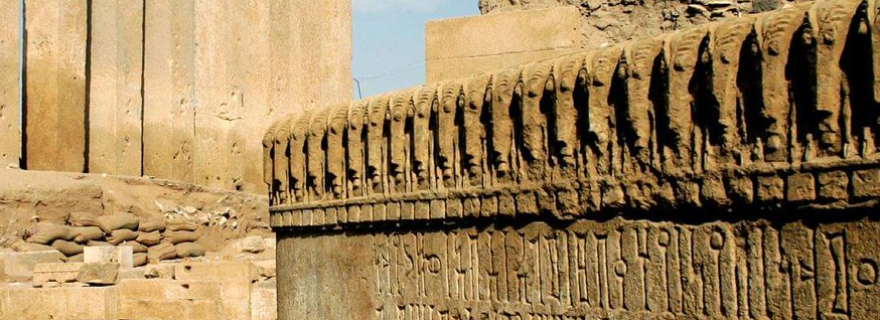Old Weird Arabia: South Arabian Inscriptions and Medieval Islam
When the first Muslims came to Yemen, they came across thousands of ancient inscriptions, written centuries before by South Arabia’s pre-Islamic rulers. Medieval Muslims came to re-interpret these inscriptions to fit their own worldviews, from ancient warnings to memories of heroic deeds.
In the early eleventh century CE, the North African scholar Abū Bakr al-Malikī visited the ruins of Carthage. While there, al-Malikī saw an ancient inscription written on its walls. According to him, it read: “I am ʿAbdallāh, son of al-ʾArāšī, envoy of God’s Messenger Ṣālih, who sent me to this city to call them to God.” Al-Malikī’s observation is peculiar, as he mentions the inscription was written in “Himyaritic,” referring to the ancient kingdom that ruled Yemen before Islam. Did a South Arabian inscription really end up in Carthage?
Around the year 1100 BCE, the communities of South Arabia (what is now Yemen, southwestern Saudi-Arabia, and western Oman), who spoke a group of Semitic languages we now call “Ancient South Arabian” began to write inscriptions. To do this, they adopted the so-called South Semitic script, which, originating in the Levant, found its way to South Arabia through trade routes. Although the South Semitic and Arabic scripts share a distant ancestor, because of divergent developments, those able to read one could not decipher the other.
Over time, the South Arabian communities formed into states. The relations between the states were generally hostile, with political conflicts being the rule rather than the exception. Only in the fourth century CE was the Himyarite confederacy, originating in what is now southwestern Yemen, able to unite all of South Arabia as a single political entity. This was a watershed moment in South Arabia’s history, as later Muslim historians would refer to anything related to South Arabia’s pre-Islamic history as “Himyaritic,” all memory of its other states having passed away.
About half a century before the birth of the Prophet, the Himyarite state came to an abrupt end, as South Arabia was conquered by the Ethiopian Aksumite kingdom. However, the many palaces and fortresses that the Himyarites had constructed survive. These are accompanied by thousands of Ancient South Arabian inscriptions, but these were indecipherable for almost all later Muslim authors.
As history transformed into folklore, the Muslim authors re-interpreted the Ancient South Arabian writings, which they called musnad, to fit their own worldviews. Some scholars connected them to events and characters mentioned in the Qur’ān, others saw in them ancient warnings, and others still considered them just strange and fascinating objects.
Al-Maliki, whom we saw in the beginning, is not the only medieval author who grafted Quranic stories onto ancient inscriptions. The tenth-century scholar al-Hamdānī, called Lisān al-Yaman, “The tongue of Yemen,” for his vast knowledge of anything South-Arabia-related, tells us plenty such stories. As a Yemeni native, he was well acquainted with the region’s antiquities, having visited the region’s ancient fortresses himself. In reference to and embellishing the Qurʾānic chapter Sheba (sabaʾ), al-Hamdānī tells us how Solomon ordered a group of demons (šayāṭīn) to build a series of fortifications for the Queen of Sheba, whom the Islamic tradition calls Bilqīs. And seeing some half-faded inscription on the walls of one of these fortresses, al-Hamdānī then tells us it was written by one of these demons (Iklīl VIII:23-4).
Such interpretations of the South Arabian inscriptions is more fiction than fact. Medieval Muslim authors were not so much interested in the actual content of the inscriptions than what they thought they represented. Apart from fortresses, the South Arabian landscape was also dotted with ancient tombs. These, too, fascinated al-Hamdānī, who devotes a good part of his writings to so-called qubūriyyāt, from the plural of the Arabic qabr, “grave.”
Al-Hamdānī recounts the story of a man from Ḥaḍramawt in eastern Yemen, who, in his youth stumbled upon the grave of the Prophet Hūd. The Qurʾān says: “[A]nd to ʿĀd we sent their brother Hūd, who said: ‘O, my people, worship God; there is no other deity for you than him, you are naught but liars.” After some difficulties the man finds Hūd’s body, conveniently accompanied by an ancient inscription, which reads: “I am Hūd, who believed in God; I was saddened by ʿĀd, their disbelief, and their straying from God’s cause.” (Iklīl VIII:133)
The inscription-cum-warning trope found its way to other Muslim scholars and historians as well. The historian Al-Ṭabarī (d. 923) recounts the raid of a South Arabian king in North Africa. Arriving at the edge of a desert, he sent some men across it to explore. When they did not return, al-Ṭabarī mentions a chilling inscription left by the king: “This is the statue of Yāsir ʾAnʿam, the Ḥimyarite. There is no passage behind it; whosoever ignores this shall certainly perish”.
These stories show how strongly the South Arabian inscriptions spoke to the medieval scholars’ imagination. Although their real content was now inaccessible, they came to represent something else: a memory of an old, weird Arabia, filled with legendary kings, doomed prophets, and ancient tombs.
Interested in this topic? Make sure to come to Imar Koutchoukali's What's New lecture on 23 September. For more information click here.



0 Comments